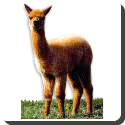 Alpaca — The Alpaca (Vicugna pacos) is a domesticated species of South American camelid. It resembles a small llama in superficial appearance.
Alpaca — The Alpaca (Vicugna pacos) is a domesticated species of South American camelid. It resembles a small llama in superficial appearance.
Alpacas are kept in herds that graze on the level heights of the Andes of Ecuador, southern Peru, northern Bolivia, and northern Chile at an altitude of 3500 to 5000 meters above sea-level, throughout the year. Alpacas are considerably smaller than llamas, and unlike them are not used as beasts of burden but are valued only for their fiber. Alpaca fiber is used for making knitted and woven items, much as sheep’s wool is. These items include blankets, sweaters, hats, gloves, scarves, a wide variety of textiles and ponchos in South America, and sweaters, socks, coats and bedding in other parts of the world. The fiber comes in more than 52 natural colors as classified in Peru, 12 as classified in Australia and 22 as classified in America. Alpacas and llamas differ in that alpacas have straight ears and llamas have banana shaped ears. Aside from these differences, llamas are on average 1-2 feet taller and proportionally bigger than alpacas.
In the textile industry, “alpaca” primarily refers to the hair of Peruvian alpaca, but more broadly it refers to a style of fabric originally made from alpaca hair but now often made from similar fibers, such as mohair, Icelandic sheep wool, or even high-quality English wool. In trade, distinctions are made between alpacas and the several styles of mohair and luster.
Alpacas are social herd animals that live in family groups consisting of a territorial male, females and their young. They are gentle, elegant, inquisitive, intelligent and observant. As they are a prey animal, they are cautious and nervous if they feel threatened. They like having their own space and may not like an unfamiliar alpaca or human getting close, especially from behind. They warn the herd about intruders by making sharp, noisy inhalations that sound like a high pitch burro bray. The herd may attack smaller predators with their front feet, and can spit and kick. Due to the soft pads on their feet, the impact of a kick is not as dangerous as that of a hoofed animal, yet it still can give quite a bruise, and the pointed nails can inflict cuts.
 Kids Portal For Parents India Kids Network
Kids Portal For Parents India Kids Network






